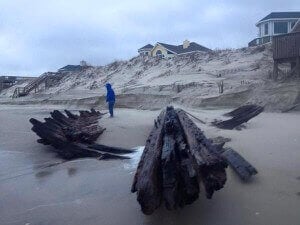3D printing is helping to document shipwrecks and make sure we don’t lose out on important pieces of history forever.
John McCord and Nathan Richards, education programs coordinator and head of the Maritime Studies Program at the Institute in Wanchese, are among the first researchers to use photogrammetry to rapidly produce 3D images and models of North Carolina shipwrecks.
Richards and McCord recently used photogrammetry to record a longtime landmark on the Corolla beach frequently that appears and disappears – the O’Keefe wreck, named after Charles O’Keefe who discovered it in the 1990s. The timbers are believed to be the remains of the Civil War streamer Metropolis, which sank off Currituck in 1878.
The Outer Banks coast is famously known as the Graveyard of the Atlantic as thousands of ships have sunk just off its shores. On occasion, a wreck is spat out onto the beach. However, usually the ocean quickly breaks it apart, takes it away or buries it in sand.
“One minute they are there and the next minute they are washed out to sea,” Richards told The Virginian Pilot. “Part of what we’re looking to do is get to the shipwreck very fast, soon after they are uncovered, or discovered, with minimal equipment and capture the most accurate data in a short time.”
How Do They 3D scan the Shipwrecks?
To capture the O’Keefe wreck, McCord took photos from above using a drone and Richards used a camera to do the same from the ground, including up under the nearly sand-covered ribs.
Richards took close-up images on the beach, including under the exposed areas while McCord captured areal data of the wreck using a drone fitted with a powerful camera. The process took around twenty minutes and then the images were loaded into the computer software which allowed them to 3D print a highly accurate, full-color model of the shipwreck in a little over an hour.
Just seven years ago, in order to complete a similar project a crew of five people had to work for four days and hundreds of hours to produce a less accurate drawing. Thanks to this technology, research is made cheaper and safer and requires less time and fewer people. However, even with the photogrammetry, the scientists will still make on-site visits to study characteristics such as workmanship and the artifacts’ material composition, Richards said.
“The next project is whatever wreck is next exposed,” Richards said.
What other historic landmarks do you think should be captured with photogrammetry?
License: The text of "3D Images Help Print a Resource for Documenting Shipwrecks" by All3DP is licensed under a Creative Commons Attribution 4.0 International License.
